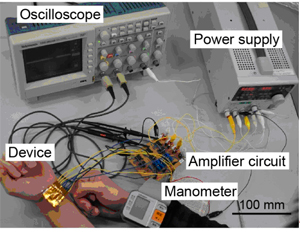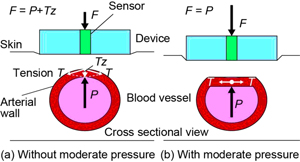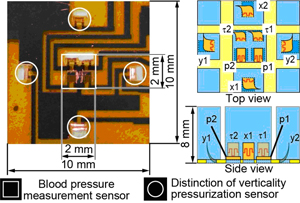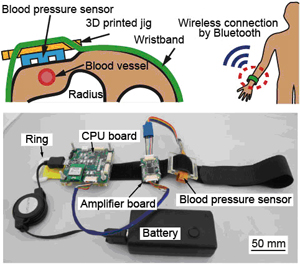Top>Opinion>Measuring Blood Pressure with MEMS
 Index
Index

Tetsuji Dohi【profile】
Measuring Blood Pressure with MEMS
Tetsuji Dohi
Associate Professor, Faculty of Science and Engineering, Chuo University
Area of Specialization: Micro nano-devices
What is MEMS technology?
Do you know the word MEMS? This term, unfamiliar in Japan, is the acronym of Micro Electro Mechanical Systems. It has often been mentioned as micro machines in Japan since the 1990s, meaning minute electronic machinery built with mechanical elements that apply the manufacturing technique for semiconductor integrated circuits used in CPUs or memory for PCs. Major products created with this MEMS technology include digital micro mirror devices for projectors, printer heads for ink-jet printers, and accelerometers and angular velocity sensors for smart phones and game controllers. This is a relatively new technology based on which commercialized devices have increasingly appeared on the market in recent years.
This MEMS technology has three features: it is small, light and fast. In fact, the word micro is also used as a unit of length, i.e., 1 µm (micrometer), which is 1/1000 of 1 mm. Given that the diameter of a human hair is about 80 µm, it is understandable that a product built with the MEMS technology is too small and fine to see with the naked eye. Lightness is one of the features resulting from this smallness. The weight of water in the shape of a 1 cm × 1 cm cube is 1 g. That of a 100 µm × 100 µm cube, 1/100 on a side, becomes 0.000001 g, which is too light to feel with the human body. The weight of an object is proportional to its volume, which is, in turn, proportional to the cube of its length. Based on this fact, it can be imagined that reducing an object in size makes it even lighter. In reality, it becomes unimaginably lighter. Applying this MEMS technology, we at the Micro Systems Laboratory are studying how to measure various types of human information.
Measuring blood pressure with the tonometry method
Figure 1 shows a study to prototype a small, high-performance sensor using the MEMS technology and measure human blood pressure with this MEMS sensor.[1] While more people are aware of health in recent years as society ages, expectations for early detection and daily measurement of hypertension have increased in particular, since it has the potential to develop into various diseases. Today, a common method for measuring blood pressure is to use an arm band called a cuff, but this method has the problem that it places a large burden on the patient because it stops the blood flow temporarily. This method is, therefore, unsuitable for frequent measurement in one day, and an easier method for measuring blood pressure which imposes less of a burden on the patient is hoped for.
Thus, our lab is studying how to achieve a blood pressure measurement device that can be used daily with a low burden on the patient, using a blood pressure measurement method called the tonometry method, based on a small, high-performance MEMS sensor prototyped with the MEMS technology. The tonometry method is a way to detect blood pressure percutaneously by pressing a pressure sensor on an artery, such as a radial artery, that is located near the body surface (Figure 2). In this measurement method, the upper part of the blood vessel is made flat by pushing it with appropriate strength. At the flat area on the upper part of the blood vessel, the tension of the blood vessel works at right angles to the direction of the pressure sensor’s pressure sensing. The blood pressure, therefore, can be measured directly because the force measured by the pressure sensor becomes equal to the blood pressure.

Figure 1: Blood pressure measurement with a MEMS sensor

Figure 2: Mechanism of measuring blood pressure with the tonometry method
MEMS triaxial force sensor and blood pressure measurement
Measurement with the tonometry method is a very promising approach as it is easy to use and enables the measurement of blood pressure with a low burden on the patient. One problem, however, is its low measurement precision. This is primarily caused when the sensor is not pressed parallel to the blood vessel or when the upper part of the blood vessel does not become sufficiently flat. So, we are studying a new sensor that can detect whether or not the sensor is pressed parallel and maintain its measurement precision even when the upper part of the blood vessel is not flat. We are prototyping the MEMS triaxial force sensor shown in Figure 3 as a new sensor. Applying the MEMS technology, this is a sensor that has a number of sensor elements for measuring the horizontal force (shearing stress) and sensor elements for measuring the vertical force (pressure) arranged in a small area. Installing small sensor elements that can measure the horizontal force enables to detect whether or not the device is pressed parallel, as well as to measure the diagonal force even when the blood vessel is not flat, resulting in highly precise measurement of blood pressure.
Currently, we are attempting to embed a blood pressure meter based on the MEMS triaxial sensors into a wrist-band-style system, shown in Figure 4, to enable use in daily life.[2] This is a system to measure blood pressure by wearing a watch-like band-style device that can be fixed on a wrist, which incorporates MEMS triaxial sensors, a signal processing circuit board and a battery. We seek to achieve a wearable system that can measure blood pressure daily and send data to a PC or smart phone via wireless communication.

Figure 3: MEMS triaxial sensor for measuring blood pressure

Figure 4: Wrist-band-style system
Reference:
- ^ Kei Shioya, Tetsuji Dohi, “Blood Pressure Measurement Device Based on the Arterial Tonometry Method with Micro Triaxial Force Sensor,” Proc. of Transducers 2013, pp. 2389-2392, Barcelona, Spain, Jun. 16-20, 2013.
- ^ Ryosuke Goto and Tetsuji Dohi, “Wearable Blood Pressure Measurement Device Using Micro Force Sensors [Maikuro Chikara Sensa o Mochiita Uearaburu Ketsuatsu Keisoku Debaisu],” the Sixth Symposium on Micro-Nano Engineering, 22am2-G7, Shimane, Oct. 20-22, 2014.
- Tetsuji Dohi
Associate Professor, Faculty of Science and Engineering, Chuo University
Area of Specialization: Micro nano-devices - Professor Dohi was born in Tokyo in 1975.
1999 Graduated from the Faculty of Engineering, the University of Tokyo.
2001 Graduated from the Graduate School of Engineering, the University of Tokyo.
2004 Graduated from the doctoral program, the Graduate School of Information Science and Technology, the University of Tokyo. Received a doctoral degree in information science and technology from the University of Tokyo.
2004 Postdoctoral Researcher , the Graduate School of Information Science and Technology, the University of Tokyo.
2005 Research Fellowship for Young Scientists (PD), the Japan Society for the Promotion of Science.
2006 Project Assistant Professor , the Graduate School of Information Science and Technology, the University of Tokyo.
2008 Project Assistant Professor, the Information and Robot Technology Research Initiative, the University of Tokyo.
2010 Assistant Professor, the Faculty of Science and Engineering, Chuo University, before assuming current position in 2013.
Professor Dohi’s current research interests include medical applications of micro machine technology, particularly focusing on micro coils for MRI and micro sensors for blood pressure measurement using the tonometry method.
- Research Activities as a Member of Research Fellowship for Young Scientists (DC1), Japan Society for the Promotion of Science (JSPS) Shuma Tsurumi
- Important Factors for Innovation in Payment Services Nobuhiko Sugiura
- Beyond the Concepts of Fellow Citizens and Foreigners— To Achieve SDGs Goal 10 “Reduce Inequality Within and Among Countries” Rika Lee
- Diary of Struggles in Cambodia Fumie Fukuoka
- How Can We Measure Learning Ability?
—Analysis of a Competency Self-Assessment Questionnaire— Yu Saito / Yoko Neha - The Making of the Movie Kirakira Megane








